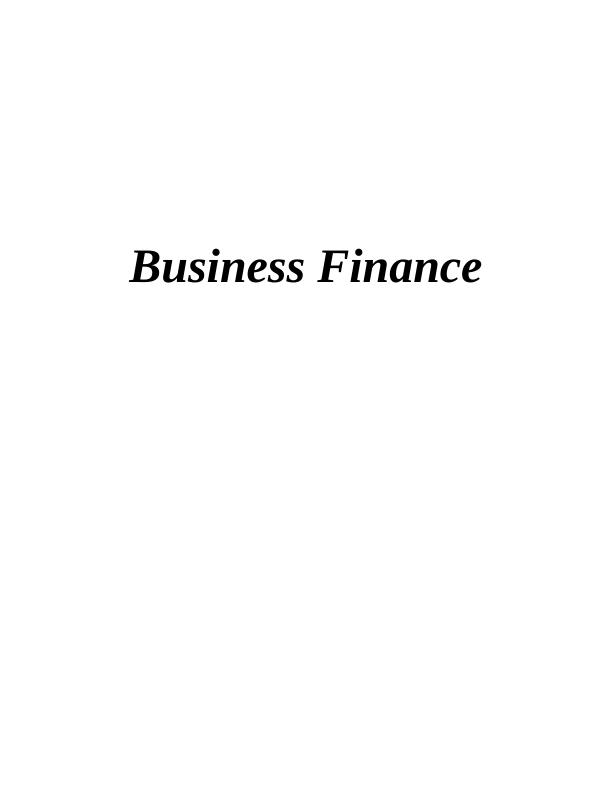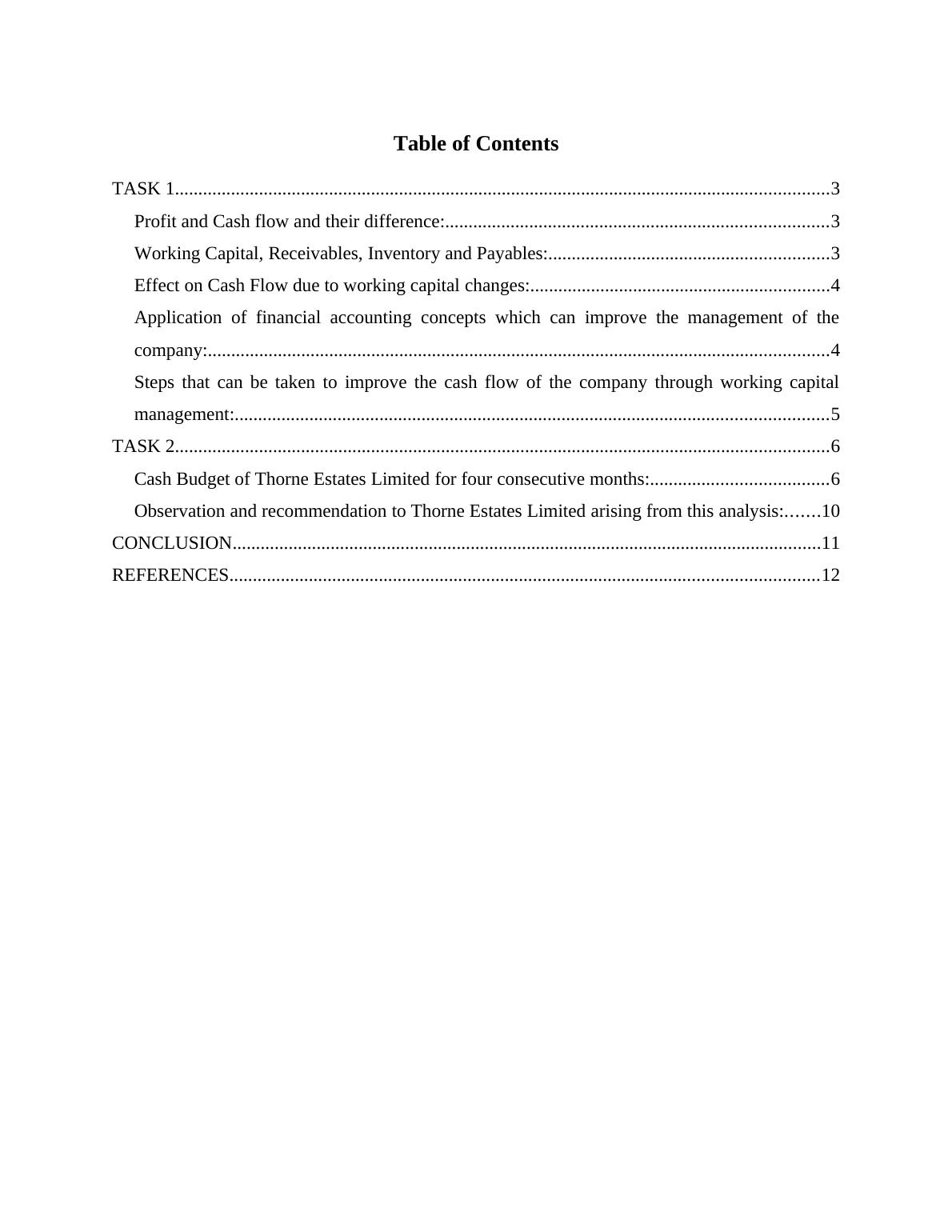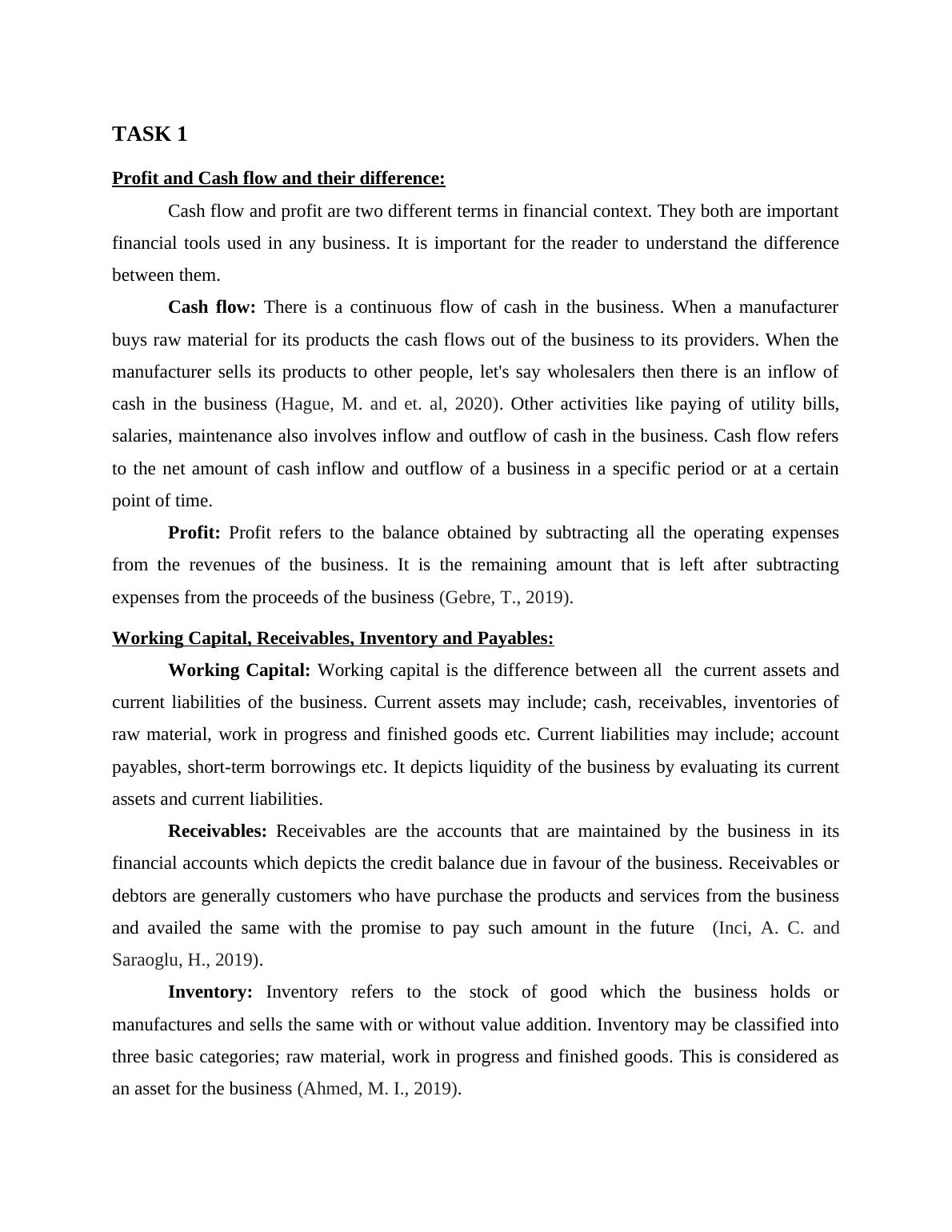Difference Between Profit and Cash Flow in Business Finance
Added on 2022-12-27
13 Pages3260 Words27 Views
Business Finance

Table of Contents
TASK 1............................................................................................................................................3
Profit and Cash flow and their difference:..................................................................................3
Working Capital, Receivables, Inventory and Payables:............................................................3
Effect on Cash Flow due to working capital changes:................................................................4
Application of financial accounting concepts which can improve the management of the
company:.....................................................................................................................................4
Steps that can be taken to improve the cash flow of the company through working capital
management:...............................................................................................................................5
TASK 2............................................................................................................................................6
Cash Budget of Thorne Estates Limited for four consecutive months:......................................6
Observation and recommendation to Thorne Estates Limited arising from this analysis:.......10
CONCLUSION..............................................................................................................................11
REFERENCES..............................................................................................................................12
TASK 1............................................................................................................................................3
Profit and Cash flow and their difference:..................................................................................3
Working Capital, Receivables, Inventory and Payables:............................................................3
Effect on Cash Flow due to working capital changes:................................................................4
Application of financial accounting concepts which can improve the management of the
company:.....................................................................................................................................4
Steps that can be taken to improve the cash flow of the company through working capital
management:...............................................................................................................................5
TASK 2............................................................................................................................................6
Cash Budget of Thorne Estates Limited for four consecutive months:......................................6
Observation and recommendation to Thorne Estates Limited arising from this analysis:.......10
CONCLUSION..............................................................................................................................11
REFERENCES..............................................................................................................................12

TASK 1
Profit and Cash flow and their difference:
Cash flow and profit are two different terms in financial context. They both are important
financial tools used in any business. It is important for the reader to understand the difference
between them.
Cash flow: There is a continuous flow of cash in the business. When a manufacturer
buys raw material for its products the cash flows out of the business to its providers. When the
manufacturer sells its products to other people, let's say wholesalers then there is an inflow of
cash in the business (Hague, M. and et. al, 2020). Other activities like paying of utility bills,
salaries, maintenance also involves inflow and outflow of cash in the business. Cash flow refers
to the net amount of cash inflow and outflow of a business in a specific period or at a certain
point of time.
Profit: Profit refers to the balance obtained by subtracting all the operating expenses
from the revenues of the business. It is the remaining amount that is left after subtracting
expenses from the proceeds of the business (Gebre, T., 2019).
Working Capital, Receivables, Inventory and Payables:
Working Capital: Working capital is the difference between all the current assets and
current liabilities of the business. Current assets may include; cash, receivables, inventories of
raw material, work in progress and finished goods etc. Current liabilities may include; account
payables, short-term borrowings etc. It depicts liquidity of the business by evaluating its current
assets and current liabilities.
Receivables: Receivables are the accounts that are maintained by the business in its
financial accounts which depicts the credit balance due in favour of the business. Receivables or
debtors are generally customers who have purchase the products and services from the business
and availed the same with the promise to pay such amount in the future (Inci, A. C. and
Saraoglu, H., 2019).
Inventory: Inventory refers to the stock of good which the business holds or
manufactures and sells the same with or without value addition. Inventory may be classified into
three basic categories; raw material, work in progress and finished goods. This is considered as
an asset for the business (Ahmed, M. I., 2019).
Profit and Cash flow and their difference:
Cash flow and profit are two different terms in financial context. They both are important
financial tools used in any business. It is important for the reader to understand the difference
between them.
Cash flow: There is a continuous flow of cash in the business. When a manufacturer
buys raw material for its products the cash flows out of the business to its providers. When the
manufacturer sells its products to other people, let's say wholesalers then there is an inflow of
cash in the business (Hague, M. and et. al, 2020). Other activities like paying of utility bills,
salaries, maintenance also involves inflow and outflow of cash in the business. Cash flow refers
to the net amount of cash inflow and outflow of a business in a specific period or at a certain
point of time.
Profit: Profit refers to the balance obtained by subtracting all the operating expenses
from the revenues of the business. It is the remaining amount that is left after subtracting
expenses from the proceeds of the business (Gebre, T., 2019).
Working Capital, Receivables, Inventory and Payables:
Working Capital: Working capital is the difference between all the current assets and
current liabilities of the business. Current assets may include; cash, receivables, inventories of
raw material, work in progress and finished goods etc. Current liabilities may include; account
payables, short-term borrowings etc. It depicts liquidity of the business by evaluating its current
assets and current liabilities.
Receivables: Receivables are the accounts that are maintained by the business in its
financial accounts which depicts the credit balance due in favour of the business. Receivables or
debtors are generally customers who have purchase the products and services from the business
and availed the same with the promise to pay such amount in the future (Inci, A. C. and
Saraoglu, H., 2019).
Inventory: Inventory refers to the stock of good which the business holds or
manufactures and sells the same with or without value addition. Inventory may be classified into
three basic categories; raw material, work in progress and finished goods. This is considered as
an asset for the business (Ahmed, M. I., 2019).

Payables: Payables are the accounts that are maintained by the business in its financial
accounts which depicts the credit balance due to the suppliers or the third party of the business.
Payables or creditors are generally suppliers who have supplied the business with some sought of
inventory. The business promises to pay such amount to the creditors in the future. It is a current
liability of the business (Hashmi, S. D. and et. al, 2020).
Effect on Cash Flow due to working capital changes:
Cash is an important component in the calculation of working capital and cash flow. In
any business there is continuous inflow and outflow of cash which results in changing working
capital and as a result cash flow of the business is affected.
For example if the business advances a long term debt from a bank then there will be a
change in the working capital due to the inflow of cash in the business. As a result inflow of cash
will also increase resulting in a positive cash flow (Weber, O. and ElAlfy, A., 2019).
Another example can be considered in which the business buys a fixed asset, let's say a
machine or a building. There will be an outflow of cash which will result in decreased balance of
current assets which will further decrease the working capital of the business. Also as a result
outflow of cash will increase resulting in negative cash flow (Elert, N., Henrekson, M. and
Sanders, M., 2019).
Application of financial accounting concepts which can improve the management of the
company:
Trend Ltd (TL) is manufacturer of gym clothing and footwear. The management have
basic knowledge about the above explained concepts of financial accounting but the application
and implementation of this knowledge is not executed properly.
The company has a positive cash flow but most of the cash inflow is from the financing
activities of the business. Trend Ltd has borrowed £35 million more as long-term debt. Which
has certainly boosted up the cash inflow of the business.
TL ha made few investing decisions as well which has certainly increased the profit of
the company. With new facilities and new machines, the company will be able to produce more
of the specified products and increase the cash flow of the business.
Debtors of the company also owes the company an amount of £10 million and £12.5
million, which reflects poor account receivables management system and long term account
receivable conversion period.
accounts which depicts the credit balance due to the suppliers or the third party of the business.
Payables or creditors are generally suppliers who have supplied the business with some sought of
inventory. The business promises to pay such amount to the creditors in the future. It is a current
liability of the business (Hashmi, S. D. and et. al, 2020).
Effect on Cash Flow due to working capital changes:
Cash is an important component in the calculation of working capital and cash flow. In
any business there is continuous inflow and outflow of cash which results in changing working
capital and as a result cash flow of the business is affected.
For example if the business advances a long term debt from a bank then there will be a
change in the working capital due to the inflow of cash in the business. As a result inflow of cash
will also increase resulting in a positive cash flow (Weber, O. and ElAlfy, A., 2019).
Another example can be considered in which the business buys a fixed asset, let's say a
machine or a building. There will be an outflow of cash which will result in decreased balance of
current assets which will further decrease the working capital of the business. Also as a result
outflow of cash will increase resulting in negative cash flow (Elert, N., Henrekson, M. and
Sanders, M., 2019).
Application of financial accounting concepts which can improve the management of the
company:
Trend Ltd (TL) is manufacturer of gym clothing and footwear. The management have
basic knowledge about the above explained concepts of financial accounting but the application
and implementation of this knowledge is not executed properly.
The company has a positive cash flow but most of the cash inflow is from the financing
activities of the business. Trend Ltd has borrowed £35 million more as long-term debt. Which
has certainly boosted up the cash inflow of the business.
TL ha made few investing decisions as well which has certainly increased the profit of
the company. With new facilities and new machines, the company will be able to produce more
of the specified products and increase the cash flow of the business.
Debtors of the company also owes the company an amount of £10 million and £12.5
million, which reflects poor account receivables management system and long term account
receivable conversion period.

End of preview
Want to access all the pages? Upload your documents or become a member.
Related Documents
Difference between Profit and Cash Flow in Business Financelg...
|13
|3223
|83
Understanding Profit, Cash Flow, and Working Capital in Business Financelg...
|11
|3136
|73
Difference between profit and cash flow with their conceptslg...
|13
|2800
|76
Budgeting Methods for Second Sight PLClg...
|10
|2510
|97
Improving Cash Flow through Working Capital Managementlg...
|12
|3330
|242
Understanding Profit and Cash Flow in an Organisationlg...
|11
|3513
|100
